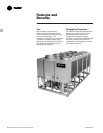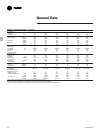
RLC-PRC016-EN8
Features and
Benefits
Electronic Expansion Valve
When coupled with Trane’s Adaptive
Control
™
microprocessor, our electronic
expansion valve significantly improves
part-load performance of the Series R
™
chiller by minimizing superheat in the
evaporator and allowing the chiller to
run at reduced condensing
temperatures. Chillers which use
conventional TXV’s must run at higher
head pressures and consume more
power than necessary at part-loads.
Additionally, the electronic expansion
valve and its controls allow much better
stability and control over dynamic load
and head changes. Under these
conditions a conventional TXV may
never achieve control stability and
extended periods of TXV “hunting” and
liquid slugging are common.
Capacity Control and Load Matching
Infinitely variable compressor
modulation allows the compressor
capacity to exactly match the building
cooling load. Reciprocating and screw
chillers that rely on stepped capacity
control must run at a capacity equal to or
greater than the load. Much of this
excess capacity is lost because
overcooling goes toward building latent
heat removal, causing the building to be
dried beyond normal comfort
requirements. The result is an increase in
chiller energy costs, particularly at the
part-load conditions at which the chiller
operates most of the time.
PID Chilled Water Setpoint
Control Through Slide Valve
Modulation
Maintain Chilled Water Supply Within
±
1
/2°F of Setpoint
Chillers that have step capacity control
typically can only maintain water
temperature to around ± 2°F. With the
air-cooled Series R
™
chiller, maintaining
temperature control has never been so
accurate.
Reduce Compressor Cycling
Modulating capacity control offers better
compressor reliability. Compressor
cycling, typical of reciprocating
compressors, will decrease compressor
component life. Parts like motors and
valves do not stand up well to excessive
compressor cycling.
Cutaway view of Trane’s electronic expansion valve.


















